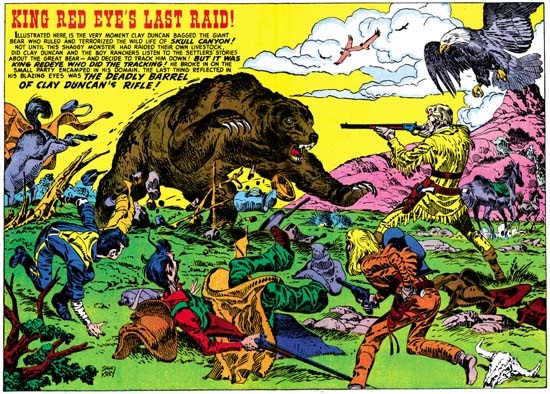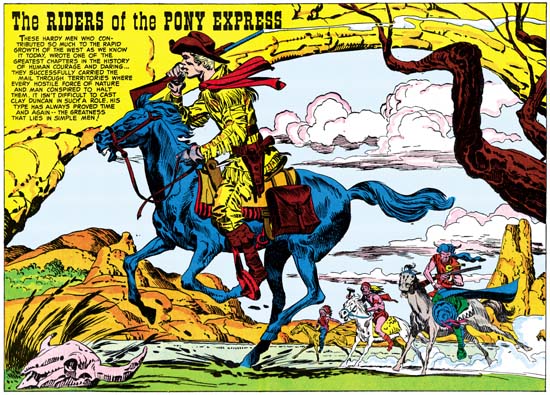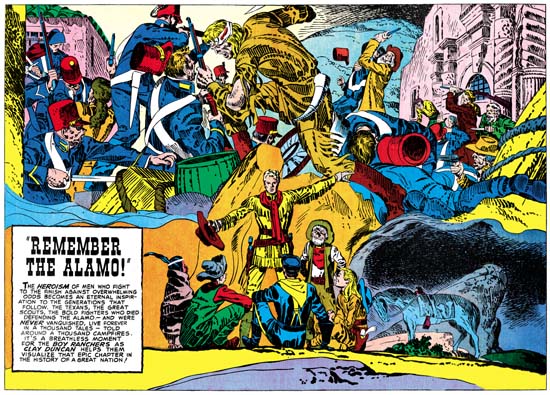
Boys’ Ranch #4 (April 1951) “King Red Eye’s Last Raid” art by Jack Kirby
Larger image
A rampaging grizzly bear, escaping horses, a kicking mule, and the scrambling youngsters of Boys’ Ranch make this image one of chaos. That is except for the firm figure of Clay Duncan as he calmly aims his rifle to make the most of his shot, probably the only one that he will manage to get off. Although the scene is supposed to be chaotic, the composition is anything but that. The mule, boys and Duncan form a broad ‘U’ shape with the bear occupying the center. Each element that forms that ‘U’ directs our attention toward the grizzly. The bald eagle might seem out of place in the portrayed scene. We would not expect the eagle to have been sleeping among the crew and there certainly would seem to be enough Americana in the picture without it. But its does serve the purpose of balancing off the caption on the opposite side of the splash. All in all a carefully composed image not at all like the true chaos found in last month’s splash “Social Night In Town” but every bit as great a piece of art.
Before I continue, I would like to offer a little digression. In 1972 I lived for a short time in Denver. One weekend I went out into the front range of the Rockies to collect fossils. The weather was dry and my original plans were to roll out the sleeping bag and spend the night under the stars. However the area I was in was cattle country and there were absolutely no trees. I found that the cattle liked to visit my car so that they could use it to rub against. I did not relish the possibility of one of them stepping on me while I slept, so I spent the night in the backseat of the car. When I returned to Denver I heard on the radio that a bear had killed some cattle only a few miles from where I was. I felt that I was pretty lucky since the cattle congregating around my car could have easily attracted the bear and had I been outside he may have found me a much easier prey. After a few weeks of killing cattle the bear was finally shot, he was the largest bear killed in Colorado in over 25 years.

Boys’ Ranch #5 (June 1951) “The Riders of the Pony Express” art by Jack Kirby
Larger image
The Pony Express rider runs his horse at full speed as he tries to escape some attacking Indians. The horse seems frantic but the rider appears almost casual with his rifle held over his shoulder. A trail of smoke exits from the gun barrel showing that the rider has already fired it once and will surely do so again if necessary. There is no question about the unpleasant intent of the Indians but the Pony Express rider seems in control of the situation. The Indians are not trailing behind the rider so they appear to have been trying to cut him off. It makes for an interesting composition with the farthest Indian almost at the center with nearer natives placed increasingly towards our right with the Pony Express rider bring the movement back towards the left. That is not the only way the eye is directed, an overhanging rock formation and some tree branches form an oval with all the riders. The caption rests comfortably on the right portion of the rocky arch. It is truly amazing the variations that are found in these wide pinups, each have their unique composition.

Boys’ Ranch #6 (August 1951) “Remember the Alamo” art by Jack Kirby
Larger image
Clay Duncan enthralls his friends while spending the night out in the prairie with tales of the heroics of the defenders of the Alamo. The lower half of the splash depicts the cast of the Boys’ Ranch while the upper half portrays a dramatic battle. What a battle it is, fully in the Kirby tradition. Gun play takes a decidedly second place to hand to hand combat. This is not an all-over composition like we saw in “Social Night in Town”. A large figure occupies the center separating a left portion of large, mostly Mexican, figures from a right field where the large fallen Mexican figures reveal smaller fighters and a building behind. It would almost seem that the Texans were winning the battle! The only Texan that appears to be in immediate trouble is one in the right background who holds his hands to his face. Of course the Texan success could only be true for a relatively short time before they would succumb to the overwhelming numbers of their opponents. The hard struggle they have had up to this point is suggested by the head bandage and torn costume of our central fighter. He, and two others, one on each side, are obviously frontiersmen. I am tempted to identify the center figure as Jim Bowie because of the large knife he welds, mostly out of the frame. Also tempting would be to identify the wearer of a coon-skin hat as Davy Crockett except that there are two of them. Note how the one on the right brandishes his rifle in the same matter that Crockett does on the cover to Western Tales #32 (March 1956). The central figure’s outfit visually links him to the similarly garbed Clay Duncan below but more importantly suggests a common heroic nature. What a shift from the drama above to the quiet scene below. The members of the Boys’ Ranch are bunched up in the center with backdrops of rock formations and night sky. A lone horse is seen on our right compositionally balancing the caption that appears on the opposite side of the splash. The horse should be unsaddled for the night but a shoe horn and stirrups can be seen but not the rest of the saddle. It is the sort of thing I would expect from Jack, but not from Joe who rode a horse in the Coast Guard. It is however a minor and easy to overlook flaw.
Often the inspiration for Simon and Kirby creations can be found in cinema of the period. Jack and Joe were both of the age that they likely saw the movie “Heroes of the Alamo” but that was released in 1937 and thus does not explain the appearance of the Alamo theme at this particular time. Alamo movies and TV shows became more popular a few years later starting with “The Man from the Alamo” (1953), then “The Last Command” (1955), “Davy Crockett at the Alamo” (1955), “The First Texan” (1956) and pretty much ending with “The Spirit of the Alamo” (1960). The “Davy Crockett at the Alamo” is particularly important as it was part of the made for TV series that Disney produced about Davy Crockett that started a craze among young boys. Afterwards the Alamo largely disappeared from popular culture. At least part of this can be blamed on a shift in social attitudes; one of the freedoms the Texan’s were fighting for was the right to own slaves. Another attempt at the theme was done in 2004 with the film “The Alamo” but it did not achieve much success.
It would not be possible for me to overemphasize what a successful piece of art I think “Remember the Alamo” is. The combination of the action and quiet scenes was done so well it is easy to overlook how unnatural it really should have been. It is arguably the best of the double page pinups from the Boys’ Ranch titles and one of Simon and Kirby’s greatest creations. With the end of the Boys’ Ranch title wide pinups or splashes would disappear from S&K publications for the next few years. For Simon and Kirby it was a relatively quiet period with only one new title, Strange World of Your Dreams in 1952. This was followed by a flurry of new comics starting with Captain 3D (December 1953). The wide format’s small part of the activity will be covered in the next chapter.

